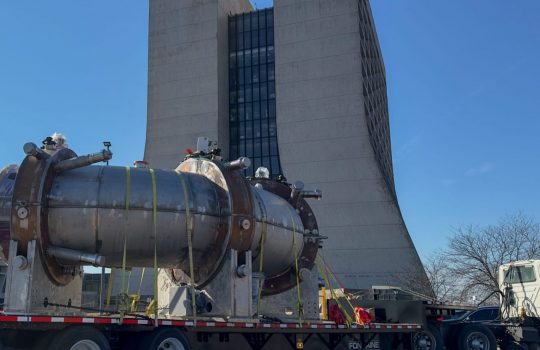Soudan, Minnesota–Deep in a former iron mine in what is now a Minnesota state park, scientists and government officials today (July 20) wielded pickaxes to chip away, at least symbolically, at the mysteries surrounding the subatomic particles known as neutrinos. The miners-for-a-day in the Soudan Underground Mine State Park included Dr. John O’Fallon of the U.S. Department of Energy, Professor Earl Peterson of the University of Minnesota, Dr. Michael Witherell, director of DOE’s Fermi National Accelerator Laboratory, Professor Stanley Wojcicki of Stanford University and Minnesota state and university officials. They took the first steps in carving out a huge cavern, half a mile underground, that will be home to a 5,000-ton steel particle detector. Physicists of the 200-member MINOS (Main Injector Neutrino Oscillation Search) experiment will use the detector to explore the question of neutrino mass.
Until recently, scientists believed that, unlike other fundamental particles of matter, neutrinos possessed neither mass nor electric charge. However, recent results from experiments in Japan, in Soudan itself and elsewhere seem to point to a small mass for these elusive particles. Because they are so numerous-each square meter of the atmosphere contains about 300 million-even a small mass for the neutrino would have big consequences for our understanding of the nature and distribution of mass in the universe.
For the MINOS experiment, physicists at DOE’s Fermilab, located 40 miles west of Chicago, will use Fermilab’s newly-completed Main Injector particle accelerator to direct an intense beam of one type of neutrinos, called muon neutrinos, to the underground Soudan detector, 450 miles away. Beginning in early 2003, MINOS collaborators will use the detector to determine whether some of the muon neutrinos in the beam have changed to another type, known as tau neutrinos. Such a change, or oscillation, from one type to another, would constitute clear evidence for neutrino mass and would allow physicists to begin to calculate just how much mass the particles possess.
“This is an exciting opportunity in neutrino research,” said Secretary of Energy Bill Richardson, whose Energy Department funds over 90 percent of federally sponsored particle physics research in the U.S. “New results are yielding fresh insight into these fundamental particles, and in turn, into the nature of matter and the universe. It is also an excellent example of international scientific cooperation, with hundreds of scientists worldwide participating, and funding partnerships that likewise span the globe.”
The MINOS experiment differs from earlier neutrino-mass experiments because it uses an accelerator-produced beam of neutrinos rather than naturally-occurring neutrinos that stream to earth by the billions from reactions in the sun and from cosmic ray interactions in the atmosphere. Earlier experimenters detected fewer solar and cosmic-ray neutrinos than they expected at detectors here on earth, leading them to conclude that one type of neutrino had oscillated to another type and hence”disappeared” from detection. In contrast, the MINOS experiment is designed to detect not only the disappearance of muon neutrinos, but also their appearance as neutrinos of a different type, tau neutrinos.
^ÓThe study of fundamental properties of neutrinos is coming of age,” said University of Minnesota Professor of physics Earl Peterson, who manages the, university’s Soudan Laboratory.”Solar and our own atmospheric experiments have given us very remarkable data and opened up new possibilities for our understanding of neutrinos. Now we need accelerator experiments to resolve the possibilities and answer the questions they have raised.”
Locating the detector half a mile below ground allows scientists to screen out cosmic rays that would otherwise flood the particle detector with unwanted signals. The changeover from iron mining to mining the secrets of subatomic particles also provides economic stimulus to the northeastern Minnesota area. The addition of construction jobs and operating personnel at the Soudan site is estimated to contribute up to $15 million to the local economy in the next few years. Iron ore for the $45 million detector’s 486 steel plates will come from the Hibbing Taconite Company in nearby Hibbing, Minnesota.
The MINOS experiment is a collaboration of some 200 scientists from DOE’s Argonne National Laboratory, the University of Athens (Greece), the California Institute of Technology, the University of Chicago, JINR Dubna (Russia), DOE’s Fermilab, Harvard University, IHEP Beijing (Peoples Republic of China), Indiana University, ITEP(Russia), Lebedev Institute (Russia), DOE ‘s Lawrence Livermore National Laboratory, University College London, the University of Minnesota, Oxford University, the University of Pittsburgh, IHEP Protvino (Russia), Rutherford Laboratory (England), the University of Sussex (England), Texas A&M, the University of Texas at Austin, Tufts University, and Western Washington University. Funding for the project comes from DOE, the National Science Foundation, the State of Minnesota, and science funding agencies abroad.
Fermilab is a Department of Energy National Laboratory dedicated to frontier research in the field of particle physics. More than 90 percent of the funding for federally sponsored research in particle physics is provided by DOE. Fermilab is operated by Universities Research Association, Inc. under contract with DOE.
For more information, call Fermilab’s Public Affairs Office at (630) 840-3351.



